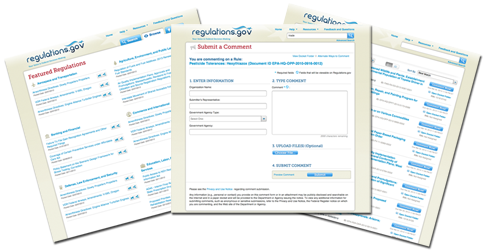Lesson 4: How the Process Works
Topic 6: Publish in the Federal Register
In this topic, you will learn about step six of the U.S. market access process: Publishing a proposed rule or notice in the Federal Register and taking comments.
Objective:
- Describe the comment submission process, including who can comment, how comments are received, and how comments are made available to the public once they are submitted
As discussed in Lesson 3, publication in the Federal Register constitutes official proclamation of the proposed action. A U.S. government agency can then assume that everyone knows about it. In some cases, APHIS may also conduct outreach to interested parties, explicitly encouraging them to read the action and submit comments. When the proposed rule or notice is published in the Federal Register, APHIS also notifies the WTO if the action is related to SPS obligations.
The Administrative Procedure Act specifies that proposed rules must have a comment period, but does not specify how long the period should be. Typically, proposed rules and notices relating to market access requests have comment periods of 60 days. If an action is especially complex or otherwise noteworthy, APHIS may ask for comments for a longer period of time. APHIS may also extend the comment period if a commenter requests it. APHIS does not consider comments received after the close of the comment period when developing its final action. If a late comment raises issues that APHIS wishes to consider, APHIS will reopen the comment period and ask for further comments, along with accepting all comments that came in between the close of the comment period and its reopening.
Although APHIS only notifies some actions to the WTO, anyone can comment on any APHIS proposed rule or notice. APHIS routinely receives comments from industry, exporters and importers, researchers, State and local governments, public interest groups, and foreign governments. Accepting comments from anyone and letting interested parties know about APHIS actions when they are published increases the chances that APHIS will receive comments that improve the proposed action.
 Most comments are submitted and received through Regulations.gov. Commenters also have the option of sending comments through the mail directly to APHIS. If a foreign country submits comments to the WTO point of contact, APHIS will add them to the docket, as long as they are received by the WTO point of contact before the close of the comment period.
Most comments are submitted and received through Regulations.gov. Commenters also have the option of sending comments through the mail directly to APHIS. If a foreign country submits comments to the WTO point of contact, APHIS will add them to the docket, as long as they are received by the WTO point of contact before the close of the comment period.
APHIS makes the comments it receives available on Regulations.gov, but only after reviewing them. This allows APHIS to filter out profane comments or comments that were filed on the wrong action. For this reason, comments will not show up on Regulations.gov immediately after they have been submitted. When a comment is submitted on Regulations.gov, the site generates a tracking number. That tracking number can then be searched a couple days after submission to verify that it is on the site.
If the proposed rule or notice is especially significant or controversial, APHIS may also announce public hearings on the action. The proposed rule or notice will specify the time and location of these hearings. Comments made at public hearings are treated as formal comments on the action, and a transcript of the comments is included in the administrative record for the action.
The docket is also available in a reading room in USDA headquarters in Washington, D.C., but most users find Regulations.gov to be a more convenient way to access docket materials, read comments, and submit comments.
In this topic, you learned about how APHIS publishes proposed rules and notices in the Federal Register and takes comments.
To continue, select Topic 7 from the Topics menu above or click here.